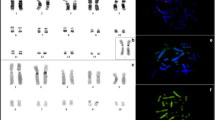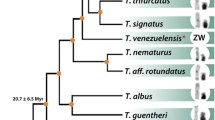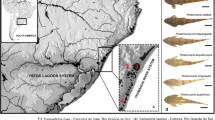Abstract
Leuciscine cyprinids possess a nearly invariant diploid number (2n = 50) with an extremely uniform karyotype comprising of 8 pairs of metacentric, 13–15 pairs of submetacentric and 2–4 pairs of subtelocentric (st) to acrocentric (a) chromosomes. The largest pair is characteristically an st/a element—the ‘leuciscine’ cytotaxonomic marker. Previously, the interspecific homology of this chromosome pair could not be assessed owing to the inability to produce euchromatic or serial banding patterns. In the present study, we used laser-microdissection (15–20 copies of the marker chromosome) to construct a whole chromosome probe (WCP) from the marker chromosome of the roach Rutilus rutilus to ascertain the interspecific homology of marker chromosomes by cross-species in-situ hybridization. WCP was hybridized to chromosomes of widely distributed (Abramis brama, Alburnoides bipunctatus, Alburnus alburnus, Aspius aspius, Ballerus ballerus, B. sapa, Blicca bjoerkna, Chondrostoma nasus, Leucaspius delineatus, Leuciscus leuciscus, L. idus, R. rutilus, Scardinius erythrophthalmus, Squalius cephalus, and Vimba vimba) and Iberian endemic species (Achondrostoma oligolepis, Iberochondrostoma almacai, I. lusitanicum, Pseudochondrostoma duriense, S. alburnoides and S. pyrenaicus). Cross-species in-situ hybridization to chromosomes of Phoxinus phoxinus, a representative of leuciscine sister lineage, showed the same pattern as in all of the leuciscins. The probe consistently hybridized to the distal part of the short arm of the marker chromosome, indicating sequence homology.
Similar content being viewed by others
References
Bianco PG, Aprea G, Balletto E, Capriglione T, Fulgione D, Odierna G (2004) The karyology of the cyprinid genera Scardinius and Rutilus in southern Europe. Ichthyol Res 51: 392–392.
Blaxhall PC (1983) Chromosome karyotyping of fish using conventional and G-banding methods. J Fish Biol 22: 417–424.
Boroń A (2001) Comparative chromosomal studies on two fish, Phoxinus phoxinus (Linnaeus, 1758) and Eupallasella perenurus (Pallas, 1814); an associated cytogenetic-taxonomic considerations. Genetica 111: 387–395.
Cunha C, Mesquita N, Dowling TE, Gilles A, Coelho MM (2002) Phylogenetic relationships of Eurasian and American cyprinids using cytochrome b sequences. J Fish Biol 61: 929–944.
Dobigny G, Ducroz JF, Robinson TJ, Volobuev V (2004) Cytogenetics and cladistics. Syst Biol 53: 470–484.
Fujiwara A, Abe S, Yamaha E, Yamazaki F, Yoshida MC (1997) Uniparental chromosome elimination in the early embryogenesis of the inviable salmonid hybrids between masu salmon female and rainbow trout male. Chromosoma 106: 44–52.
Gold JR, Li CZ, Shipley NS, Powers PK (1990) Improved methods for working with fish chromomes with a review of metaphase chromosome banding. J Fish Biol 37: 563–575.
Graphodatsky AS (2007) Comparative chromosomics. Mol Biol 41: 361–375.
Gromicho M, Coutanceau JP, Ozouf-Costaz C, Collares-Pereira MJ (2006) Contrast between extensive variation of 28S rDNA and stability of 5S rDNA and telomeric repeats in the diploid-polyploid Squalius alburnoides complex and in its maternal ancestor Squalius pyrenaicus (Teleostei, Cyprinidae). Chromosome Res 14: 297–306.
Hellmer A, Voiculescu I, Schempp W (1991) Replication banding studies in two cyprinid fishes. Chromosoma 100: 524–531.
Kubíčková S, Černohorská H, Musilová P, Rubeš J (2002) The use of laser microdissection for the prepration of chromosome-specific paintig probes in farm animals. Chromosome Res 10: 571–577.
Levan A, Fredga K, Sandberg AA (1964) Nomenclature for centromeric position on chromosomes. Hereditas 52: 201–220.
Medrano L, Bernardi G, Couturier J, Dutrillaux B, Bernardi G (1988) Chromosome banding and genome compartmentalization in fishes. Chromosoma 96: 178–183.
Nagamachi C, Pieczarka J, Milhomem S, Silva D, O’Brien P, Freguson-Smith M (2007) NOR chromosome variation detected by chromosome painting in Neotropical electric fishes (Gymnotiformes). Chromosome Res 15: 45 (Suppl. 2).
Phillips RB, Konkol NR, Reed KM, Stein JD (2001) Chromosome painting supports lack of homology among sex chromosomes in Oncorhynchus, Salmo and Salvelinus. Genetica 111: 119–123.
Phillips RB, DeKoning J, Morasch MR, Park LK, Devlin RH (2007) Identification of the sex chromosome pair in chum salmon (Oncorhynchus keta) and pink salmon (Oncorhynchus gorbuscha). Cytogenet Genome Res 116: 298–304.
Ráb P, Collares-Pereira MJ (1995) Chromosomes of European cyprinid fishes (Cyprinidae, Cypriniformes). A review. Fol Zool 44: 193–214.
Rábová M, Ráb P, Ozouf-Costaz C, Ene C, Wanzeböck J (2003) Comparative cytogenetics and chromosomal characteristics of ribosomal DNA in the fish genus Vimba (Cyprinidae). Genetica 118: 83–91.
Reed KM, Bohlander SK, Phillips RB (1995) Microdissection of the Y chromosome and FISH analysis of the sex chromosomes of lake trout, (Salvelinus namaycush). Chromosome Res 5: 221–227.
Rens W, Fu B, O’Brien PCM, Ferguson-Smith M (2006) Cross-species chromosome painting. Nat Protoc 1(2): 783–790.
Schmid M, Guttenbach M (1988) Evolutionary diversity of reverse ® fluorescent bands in vertebrates. Chromosoma 97: 101–114.
Schmid M, Steinlein C, Nanda I, Epplen JT (1990) Chromosome banding in amphibia, In: E. Olmo, ed. Cytogenetics of Amphibians and Reptiles. Basel: Birkhäuser, pp. 2–45.
Seabright M (1971) A rapid banding technique for human chromosomes. Lancet 2: 971–972.
Sumner AT (1990) Chromosome Banding. London: Unwin Hyman.
Sumner AT, Evans HJ, Buckland RA (1971) New technique for distinguishing between human chromosomes. Nat New Biol 232: 31–32.
Telenius H, Carter NP, Bebb CE, Nordenskjold M, Ponder BA, Tunnacliffe A (1992) Degenerate oligonucleotide-primed PCR: general amplification of traget DNA by a single degenerate primer. Genomics 13: 718–725.
Vasil’ev VP (1985) Evolutionary Karyology of Fishes. Moscow: Nauka Press [in Russian].
Yu QX, Fan LC, Cui JX, Ren XH, Li K, Yu XJ (1994) High resolution G-banding and idiogram on pachytene bivalents of rice field eels (Monopterus albus Zuiew). Science in China (Ser. B) 37: 1090–1096.
Zardoya R, Doadrio I (1999) Molecular evidence on the evolutionary and biogeographical patterns of European cyprinids. J Mol Evol 49: 227–237.
Zhu HP, Ma DM, Gui JF (2006) Triploid origin of the gibel carp as revealed by 5S rDNA localization and chromosome painting. Chromosome Res 14: 767–776.
Author information
Authors and Affiliations
Corresponding author
Rights and permissions
About this article
Cite this article
Ráb, P., Rábová, M., Pereira, C.S. et al. Chromosome studies of European cyprinid fishes: interspecific homology of leuciscine cytotaxonomic marker—the largest subtelocentric chromosome pair as revealed by cross-species painting. Chromosome Res 16, 863–873 (2008). https://doi.org/10.1007/s10577-008-1245-3
Received:
Revised:
Accepted:
Published:
Issue Date:
DOI: https://doi.org/10.1007/s10577-008-1245-3




